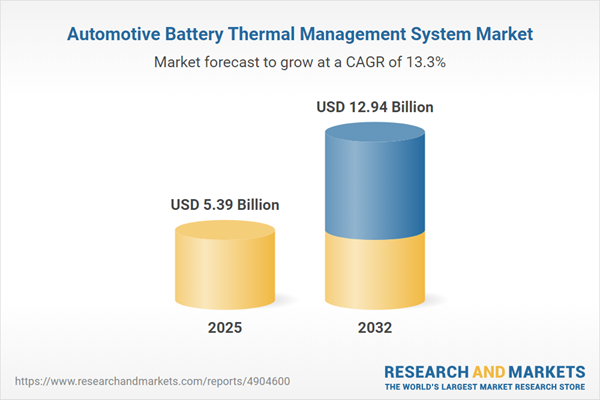Speak directly to the analyst to clarify any post sales queries you may have.
Senior decision-makers in the automotive sector are increasingly prioritizing advanced battery thermal management systems to improve reliability, support regulatory compliance, and drive effective electrification strategies amid rapidly evolving global mobility trends.
Market Snapshot: Automotive Battery Thermal Management System Market
The automotive battery thermal management system market marked strong expansion in 2024, supported by a notable compound annual growth rate and a surge in investment across multiple automotive sectors. The integration of new battery cooling and temperature control technologies continues to accelerate as electric vehicle (EV) adoption rises globally. These systems have become essential to the development of next-generation vehicle models and the modernization of existing fleets. Intensifying vehicle electrification is prompting original equipment manufacturers and fleet operators to evaluate flexible solutions capable of ensuring compliance and dependable operation in diverse regulatory and technical environments. In response to rising standards, businesses recognize the necessity of scalable battery thermal management capabilities to secure high performance and address shifting regulatory requirements. As a result, the market is forming a critical foundation for future mobility strategies within the automotive industry.
Scope & Segmentation Analysis
This report provides executive-level analysis of the core segments and technology pathways defining the automotive battery thermal management system market. The study emphasizes how product choices, deployment levels, cooling technologies, and regional factors shape electrification success and operational outcomes for senior leaders.
- Product Types: Active thermal management solutions utilize advanced fluids and integrated electronic controls for precise battery temperature maintenance, while passive systems harness conduction or radiation, catering to specific EV operational conditions.
- Cooling Methods: Air-cooling delivers straightforward system integration; liquid cooling offers superior thermal stability for sensitive battery packs; phase change materials support tailored solutions for emerging EV platforms.
- Installation Levels: Solutions are deployed at cell, module, and pack levels to deliver granular temperature control, allowing bespoke maintenance strategies for both contemporary and legacy vehicles.
- End User Segments: Commercial operators focus on maximizing system life and overall value, whereas OEMs seek lightweight designs and low-noise operations to fulfill new compliance objectives.
- Regional Coverage: The report covers North America, Latin America, Europe, Middle East and Africa, and Asia-Pacific, highlighting region-specific adoption rates and regulatory factors influencing battery thermal management choices.
- Company Coverage: Industry profiles include DENSO Corporation, Valeo SA, MAHLE GmbH, Hanon Systems, Gentherm Incorporated, BorgWarner Inc., Webasto SE, Behr GmbH & Co. KG, Setra Systems Inc., and Robert Bosch GmbH, furnishing a representative cross-section of strategic approaches within the sector.
Key Takeaways for Senior Decision-Makers
- Modular battery thermal management systems are instrumental in integrating evolving EV platforms and empower operators to adapt solutions as user needs and technology change.
- Real-time digital temperature monitoring drives improved risk management and ongoing optimization of battery performance and system reliability.
- Close collaboration with dependable suppliers and use of innovative materials builds supply chain resilience, especially when navigating volatile trade and logistics conditions.
- Increasing reliance on advanced liquid cooling methods enhances operational consistency for both commercial and passenger fleets and supports compliance with efficiency targets.
- Systems with open architecture and customizable frameworks allow businesses to swiftly address regulatory or market changes and maintain leadership in ongoing innovation cycles.
- Simplifying procurement and engineering supports stable battery system operation and advances thermal management practices throughout the automotive value chain.
Tariff Impact: Effects of 2025 United States Trade Measures
With new U.S. tariffs poised to take effect in 2025, impacting heat exchangers and critical thermal management system components, automotive manufacturers are adjusting sourcing and procurement strategies to protect their operations. These changes are causing a pronounced shift toward building robust domestic and regional supplier networks. By strengthening local supplier relationships, businesses can better buffer against cost variability and remain agile amid shifting trade conditions.
Methodology & Data Sources
This research leverages direct interviews with automotive and procurement professionals, industry benchmarking, supplier evaluations, and cost modeling. The methodology ensures the insights provided are actionable and directly aligned with the evolving priorities of senior automotive executives.
Automotive Battery Thermal Management System Market: Why This Report Matters
- Empowers organizations to strategically allocate resources for advanced battery and thermal management by forecasting regulatory and technology developments.
- Guides leadership in proactively addressing supply chain complexities and compliance challenges, underpinning steady operations and future growth.
- Provides benchmark analysis and value chain mapping to support informed, sustainable decisions throughout the automotive marketplace.
Conclusion
Investing in advanced battery thermal management is key to supporting sector progress. Organizations emphasizing flexible, forward-looking strategies will maintain reliable operations and ongoing compliance as automotive mobility evolves.
Additional Product Information:
- Purchase of this report includes 1 year online access with quarterly updates.
- This report can be updated on request. Please contact our Customer Experience team using the Ask a Question widget on our website.
Table of Contents
3. Executive Summary
4. Market Overview
7. Cumulative Impact of Artificial Intelligence 2025
List of Figures
Companies Mentioned
The companies profiled in this Automotive Battery Thermal Management System market report include:- DENSO Corporation
- Valeo SA
- MAHLE GmbH
- Hanon Systems
- Gentherm Incorporated
- BorgWarner Inc.
- Webasto SE
- Behr GmbH & Co. KG
- Setra Systems Inc.
- Robert Bosch GmbH
Table Information
| Report Attribute | Details |
|---|---|
| No. of Pages | 191 |
| Published | November 2025 |
| Forecast Period | 2025 - 2032 |
| Estimated Market Value ( USD | $ 5.39 Billion |
| Forecasted Market Value ( USD | $ 12.94 Billion |
| Compound Annual Growth Rate | 13.3% |
| Regions Covered | Global |
| No. of Companies Mentioned | 11 |









